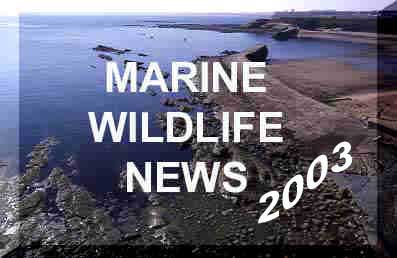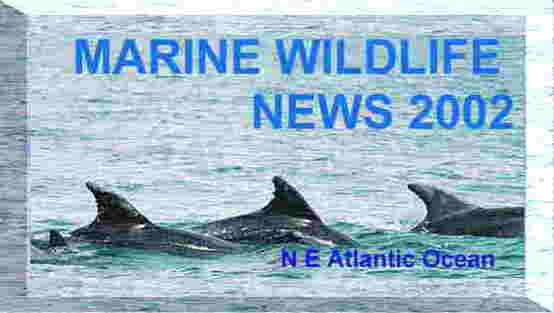
|
|
|
|
|
|
|
Norwegian Marine*** |
|
L-I-N-K-S to Other Sites (Click on Text) |
|
Smart Group |
 |
|
|
|
|
|
|
 .
.
Reports of marine wildlife from all around the British Isles, with pollution incidents and conservation initiatives as they affect the fauna and flora of the NE Atlantic Ocean.
on Microsoft Internet Explorer (best) or Netscape
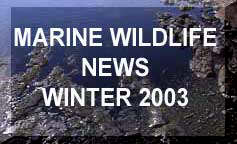 |
 |
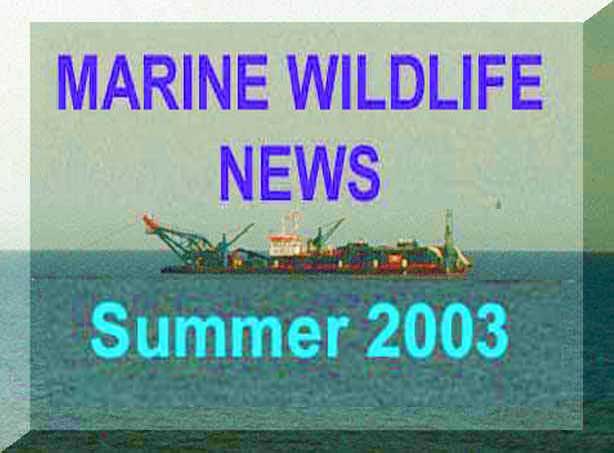 |
 |
LATEST NEWS: SPRING 2003
26 June 2003
I caught a Twaite Shad, Alosa fallax, from off the beach at Brighton.

Twaite Shad (click on the image for a closer look)
"It was about 48 cm long and like an oversized herring. Its scales were very large (I kept some as they came off easily on handling).
Report by angler Gareth Stevens
The Twaite Shad is a rare endangered migratory fish rarely caught in the English Channel. It is the commoner of the two shad species found in British waters. The other species is the Allis Shad, Alosa alosa.
Both the Twaite Shad and the Allis Shad are listed on Appendix II of the Bern Convention and Annexes II and V of the Habitats Directive. They are protected under Schedule 5 of the Wildlife & Countryside Act 1981.
Further Information and Later Report
23 June 2003
There was a mass stranding of 500+ Mauve Stingers (small jellyfish), Pelagia noctiluca, at Porthcothan, Cornwall.This is the most unusual of the British species of pelagic jellyfish to wash up, but large swarms occur in years of abundance.
Despite being a small jellyfish, it has a reputation as a stinger, in the Mediterranean.
Amongst the Sea Rocket, Orache etc, on the strandline, a Peanut Plant has taken root.Report by Jane and Nick Darke via the Cornish Wildlife Mailing ListPelagia Stings
Sea Beans page
BMLSS Jellyfish22 June 2003
We captured a large Lobster, Homarus gammarus, off a Portland (Dorset) wreck which weighed about 5 kg, but it only had one claw. The human foot in the picture is size eleven. Specimens over 5 kg are only occasionally caught incidentally in other fisheries as large lobsters cannot get into the pots. They are often covered in keelworms.
Report by Paul HarringtonBMLSS Lobster Page
BMLSS Crustacea
20 June 2003
David Blackford reports an Ocean Sunfish, Mola mola, in St Ives Bay, Cornwall. It was about a metre long, and think it is the first for the year.Report by Stella Turk via the Cornish Wildlife Mailing ListBMLSS Sunfish page19 June 2003
SHRIMPING FOR FOOD AND FUN
Local shrimper Peter Talbot-Elsden, from Southwick (Sussex), has produced a small booklet called “Shrimping for Food and Fun” about catching the brown shrimp around the coasts of Britain. The shrimps are caught in nets and the book features the various methods, firstly the push-netting seen over the sand in shallow water in spring off the Sussex coast. The famous Morecambe Bay shrimps were originally captured by cart shanker shrimping with a horse and cart in deeper water off the Lancashire coast, later replaced by a tractor. At Formby, they experimented with amphibious vehicles after World War II. Nowadays, most commercial shrimping on the east coast around King’s Lynn trawls from small boats using a net off the stern. Shrimps are often cooked on board.
The 28 page book contains 40 photographs of shrimping through the ages. It is available through Bookworms of Shoreham and other booksellers and museums at £3.50.
The booklet is also available through the British Marine Life Study Society, but at £4 including postage and packing.Peter Talbot-Elsden manned the shrimp display at Adur World Oceans Day.
15 June 2003
Whilst netting the River Hayle, Cornwall, at low water for sandeel bait, the first sweep brought a mixed bag of Greater Sandeels, Hyperoplus lanceolatus, and Lesser Sandeels, Ammodytes tobianus,plus quite a few Lesser Weevers, Echiichthys vipera. The unusual aspect was the large number of lice on the sandeel and free swimming in the bunt. Whilst ejecting the Weevers we noticed one fish had two lice stuck inside its mouth. My mate caught a louse and promptly let it go as it bit him. They were about 8 mm long. At this size they are only half the size of the adults.These are isopods (wood-lice) and expert Tammy Horton has confirmed that they are the parasitic species Ceratothoa steindachneri. Other Sand-eel netters have said that they have caught these parasites for years, which have to be removed as they are capable of killing the Sand-eels.
Report by Treve Opie originally on the Cornish Mailing ListLink to Thumbnails (Marine Wildlife of the North-east Atlantic Ocean Group)14 June 2003
A jellyfish with a bell diameter of 45 cm and one metre long was spotted off Shoreham-by-Sea, Sussex, at 7:00 pm. It was creamy white with a pink-blue rim so it was almost certainly the Barrel Jellyfish, Rhizostoma octopus. These large jellyfish are only occasionally encountered off the Sussex coast.Report by Tim Worsfield (Shoreham)
13 June 2003
We have had four separate incidents of Sandeel (family: Ammodytidae) mass mortality in Ramsey Bay, Isle of Man (a lump of rock in the middle of the Irish Sea) over the last two or three weeks. Two events co-incided with rising new moon springs and the most recent with rising full moon springs. There were no obvious causes and as with the events in other areas we can only speculate on the cause. The main question is why only these small fish? The mortalities were, not surprisingly, accompanied by frenzied gull activity.Report by Theresa Shammon (Port Erin Laboratory)
on the Marine Wildlife of the North-east Atlantic Ocean GroupNews Report
A massive bloom of plankton has turned the seas around the Shetland Isles a turquoise colour, stretching at least 60 miles, almost the whole length of the islands, from Yell the second most northern island to Sumburgh Head the southernmost tip. The organism was the coccolithophore Emiliania huxleyi which is responsible for vast blooms covering up to 40 thousand square miles of the oceans and can be seen from a space shuttle. Blooms this large can change the climate. This plankton bloom is non-toxic not thought to pose a threat to the salmon farms on the Shetlands.
Reference Book (see Chapter 6)
1999 Report of a bloom off Cornwall
- c.
11 June 2003
On the beach from Sutton-on-Sea up to Mablethorpe, East Lindsey (Easy Yorkshire), we noticed thousands of dead starfish ranging from 3-10 cm in size, along with large numbers of dead crabs and some small shellfish. The starfish were almost certainly the Common Starfish, Asterias rubens.
Previous Report of a Massive Wreck
Strandline and Beachcombing Page
10-12
June 2003
Large
numbers of pelagic scyphozoan Pelagia noctiluca,
the Mauve Stinger
(small jellyfish), were spotted all along the east coast of Lundy, Bristol
Channel. I was participating in an English
Nature drop-down video survey and I found dense shoals of this beautiful
pelagic jellyfish. The density was probably in the region of 15 to 20 indivuals
per square metre at the surface.
NB:
Swarms of this jellyfish are unusual in British seas.
on the Marine Wildlife of the North-east Atlantic Ocean Group
BMLSS Jellyfish page 2
7 June
2003
Hundreds
of the Blue Jellyfish, Cyanea
lamarckii, were seen whilst diving around the Lizard up to the
Helford river in Cornwall. Also seen in the Helford river was a Lion's
Mane Jellyfish, Cyanea
capillata, and a Compass Jellyfish,
Chrysaora
hysoscella.
The
staff at Porthkerris divers have recently seen vast numbers of By-the-Wind
Sailors,
Velella
velella, which turned the beach blue!
 6
June 2003
6
June 2003
Millions
(literally) of By-the-Wind Sailors,
Velella
velella, (a jellyfish-like animal) are being washed up alive to
perish on the shores of Cornwall, now reaching up the English Channel as
far east as Polperro and Looe. All
are very small, around 15 mm in length, and still have fleshy body parts
attached.
4 June
2003
I
was on Charmouth beach in Dorset doing a little fossil hunting and suddenly
found myself lying (best way to find tiny crinoids etc) in a wreck of tiny
jellyfish. They had a bizarre transparent float and were a vivid blue being
only around 25 to 30 mm long. These are By-the-Wind
Sailors,
Velella
velella.
Velella Notes
MARLin Velella Web Page
3 June 2003

The famous Boar Fish, Capros aper, died after its aquarium sprung a leak in the middle of the night. (It was caught from the Sussex shore at Hove in November 2002).
31
May 2003
Shoreham
bathed in a heatwave up to
24°
C for the opening of the Adur Festival and
Adur
World Oceans Day 2003 on Coronation
Green, Shoreham-by-Sea. About
3000 people attended the event that was steady and busy throughout.
Exhibits
included live fish and lobster in aquaria, colouring and badge-making,
whales
and dolphins, birds, shrimps, fish-tasting, touch-table, Shoreham shingle
beach flora and undersea colour photographs and videos.
A special thanks to all the participants, especially Len Nevell (British Marine Life Study Society) and Steve Trewhella (Marine Conservation Society). The inflated dolphin was provided by Steve Savage (Sea Watch Foundation).
Several groups had special exhibitions including the:
British
Marine Life Study Society including Shorewatch
(four exhibits)
West
Sussex County Council Countryside Unit
Sea
Watch Foundation (for Whales & Dolphins)
Sussex
Sea Fisheries District Committee
SeaSearch
(Undersea Biological Recording)
Shoreham
& District Ornithological Society
Sussex
Ornithological Society
Adur
World
Oceans Day 2003
10:00
am - 4:00 pm
Popular
Information File on Adur World Oceans Day
2003
Acrobat
Information File on Adur World Oceans Day
2003
Adur
World Oceans Day 2003 Images (by Ray Hamblett)
23
May 2003
A
young Minke Whale,
Balaenoptera
acutorostrata, became stranded on the reef as the tide dropped at Longrock,
Penzance, Cornwall. The reef was at least 200 metres from the beach
so rescuers had to wade and swim out to it.
The
whale had cuts and scraps along the underside and the tail, but these were
luckily only superficial. As the tide rose and more help arrived
the rescuers, including experts form the Silver
Dolphin Centre were able to get the whale into the inflatable pontoons
and slowly move it away from the reef. After being checked over by the
vet, the whale was safely released back out into the open waters.
Full
Report (Silver Dolphin web pages)
20
May 2003
Hundreds
of By-the-Wind Sailors,
Velella
velella, (a jellyfish-like animal) are washed up on Sennen
Cove, Cornwall.
Sennen
Cove Wildlife Page
By-the-Wind
Sailors,
Velella
velella, are being reported again in the sea and washed up on the
strandline on the north Cornish shores and Salcombe Harbour, south Devon.
On 21 May 2003 Ray Lawman has reported to Ruth Williams that he there were about half a million Velella velella at "Soapy Cove" on the Lizard, Cornwall.
18
May 2003
Tim
Bain reports seeing a 5 metre long Basking
Shark, Cetorhinus maximus,in
St Ives Harbour, Cornwall, at dusk. This shark is the largest fish found
in the seas around the British Isles and is regularly seen off the south-western
coasts but only rarely actually enters harbours.
5-7
May 2003
An
Audouin's
Gull,
Larus audouinii, was added
to the list of British birds after a second summer bird was seen,
recorded and photographed at Dungeness, Kent.
Audouin's
Gull was formerly a rare and localised species.
It is still restricted to the Mediterranean as a breeding bird, but its
numbers have risen from about 1000 pairs in the early 1970s to more than
17,000 pairs by 1995. The species is partly migratory, the main winter
quarters lying along the Atlantic Coast from Morocco, as far south as Senegal
and Gambia. The increasing population has seen an increase in extralimital
records including
four
records from France , plus three records from Switzerland. One of the French
records was from Boulogne-sur-Mer, just across the Channel from Kent.
21
April 2003
A
15 metre long male
Sperm Whale, Physeter macrocephalus,
was stranded alive on the English Channel (le Manche) coast at Oye-plage
(west of Dunkerque), France, but it died the following night.
Report
(in French)
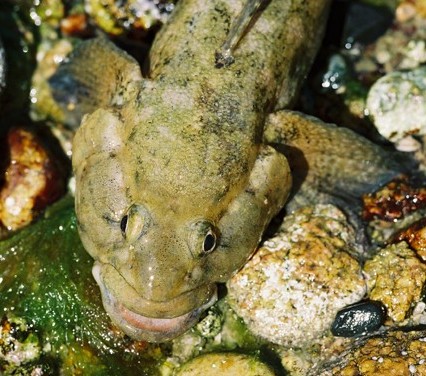 19
April 2003
19
April 2003
The
discovery of a Giant
Goby, Gobius cobitis, found in
a rockpool above the half tide mark at Les Écréhous, Jersey, was a notable
discovery. This goby is a protected species
under the Wildlife
and Countryside Act Schedule 5. It has
always been known from the shores of Jersey but it is virtually unknown
on the northern English Channel coasts with occasional records from Cornwall
only. As it name indicates this goby is a 'giant' amongst the Gobiidae,
a family of small fishes. The Giant Goby attains lengths of up to 25 cm.
On
6
August 2003, a smaller Giant Goby was found
near the same location and this one measured 22 cm.
English
Nature & MBA articles on Giant Gobies
BMLSS
Gobies
and on the Marine Wildlife of the North-east Atlantic Ocean Group
 15
April 2003
15
April 2003
The
Strawberry
Beadlet Anemone,
Actinia fragacea,
has been observed discharging eggs in an aquarium. This method of reproduction
has been suspected but there have been no observations in print before.
Full
Report Link
5 April
2003
A Sperm
Whale, Physeter macrocephalus,
is washed up dead on the Norfolk coast. This time a 15 metre long whale
became stranded on an isolated sandbank on Stiffkey Marshes (NW of Wells-next-to-Sea).
The remote location has meant that even to get a glimpse of the huge cetacean
it was necessary to wade in the water. This is a different whale from the
one discovered yesterday.
Confirmation by Elaine & Richard Francis (Sea Watch Foundation Recorders for Norfolk)
Sperm Whale (Previous Report 2003)
Sea Watch Foundation
- 4
April 2003
The second Sperm Whale, Physeter macrocephalus, of the year is washed up dead on Breasts Sands (a remote sandbank next to Terrington Marsh) on the southern coast of the Wash, East Anglia, to the west of King's Lynn.
Newspaper Report
BMLSS Cetacea
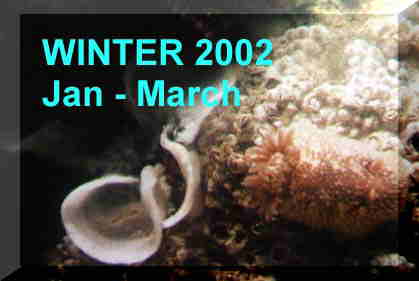 |
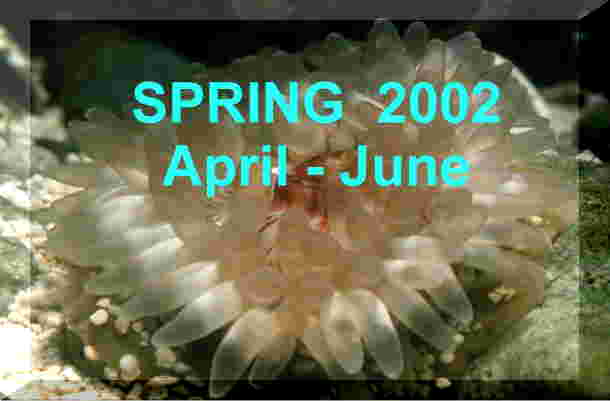 |
 |
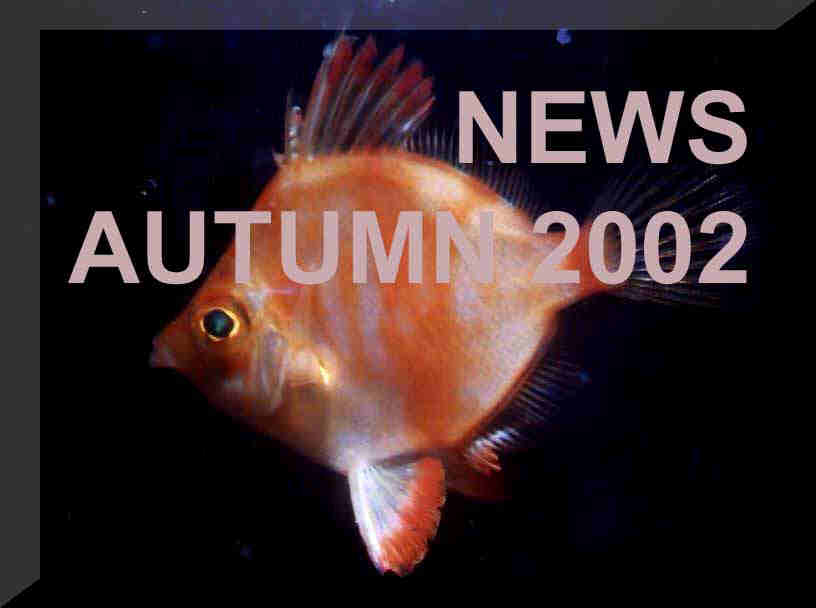 |
FOR EARLIER REPORTS CLICK ON THE BUTTON BELOW

The Marine Wildlife of the NE Atlantic Forum commences.
PLEASE JOIN

MARINE WILDLIFE of the NE ATLANTIC EFORUM PAGE (LINK TO)
News 2002
News 2001
News 2000
News 1999
|
Use these links if your are familiar with the scientific classifications of marine life |
The BMLSS (England) site commenced on 1 January 1997.
|
|
 |
 |
Andy Horton, Webmaster
|
|
|
|
|
|
Membership Form |
News 2001 News 2000 |
